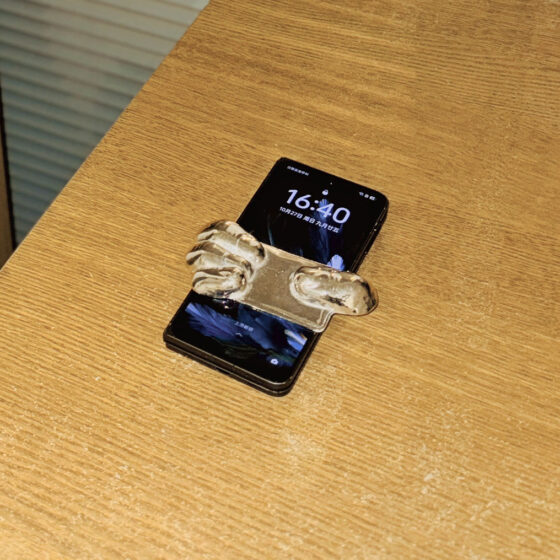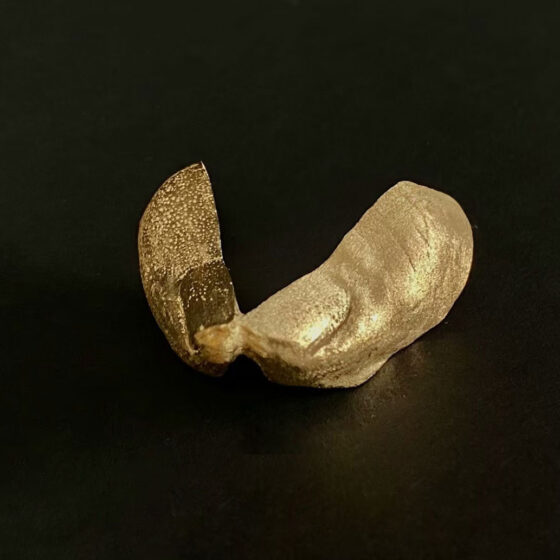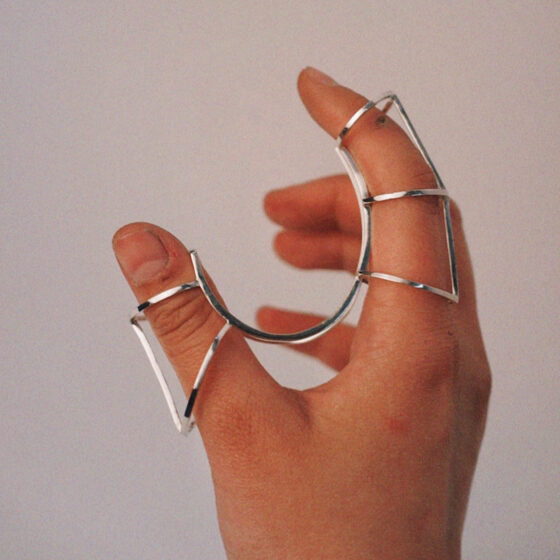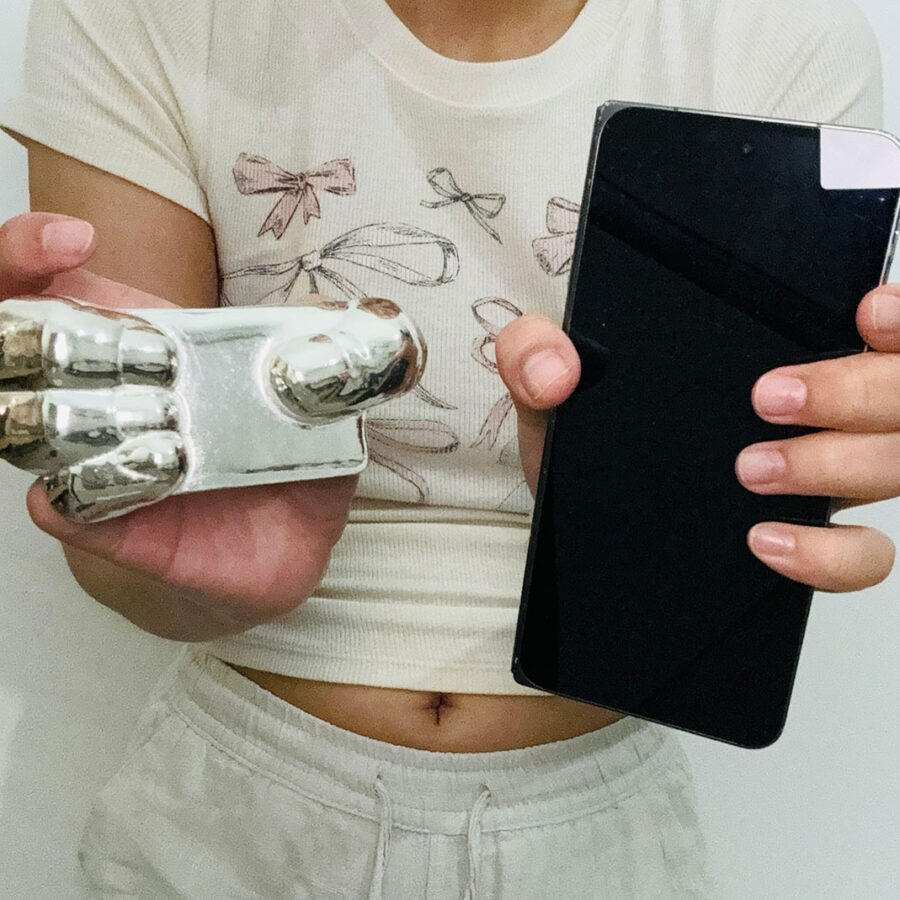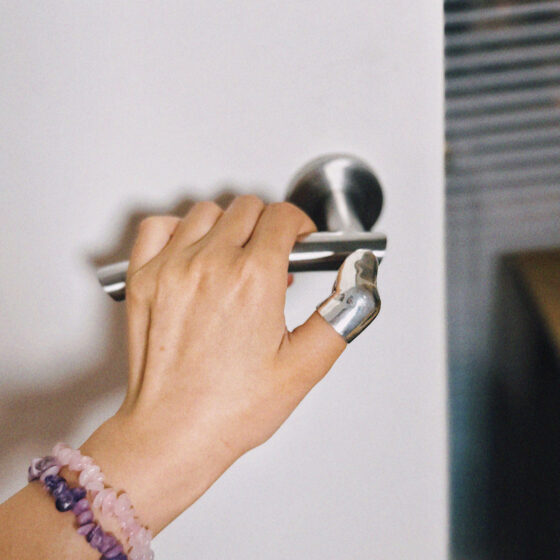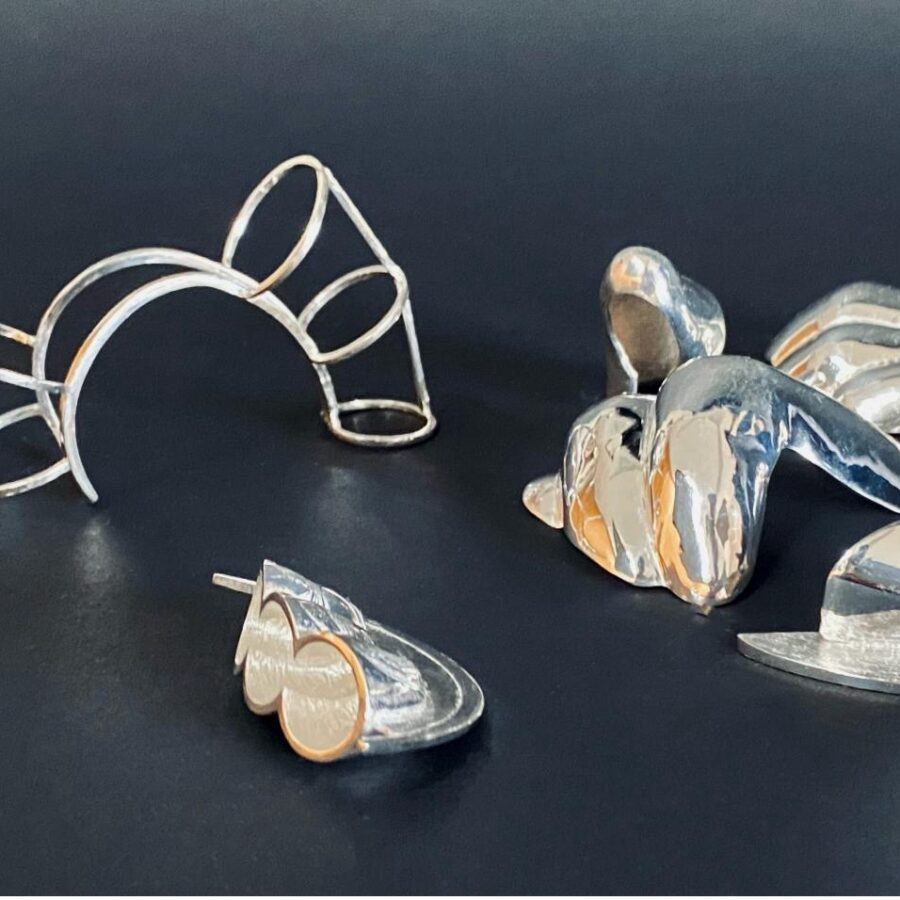
In this interview, the artist behind the Intimate Touch collection invites us into a world where objects do not decorate — they diagnose. We talk about a lost jade bracelet, fingers reshaped by digital gestures, and jewelry as a form of silent resistance. It’s a conversation about tactile memory, research as ritual, and the power of a form that touches before it is seen.
• What is your first memory with jewelry?
My earliest memory of jewelry is about tactile. As a child, I had the idea to express the growth patterns I saw in tree rings through making. The finished product was lost, but the recognition and encouragement I received from those around me brought me a great sense of achievement. The uniqueness and personal meaning of my creations deepened my desire to have these works cherished by others as meaningful and lasting works. This naturally led to my desire to become an artist and someone who can inject something truly special into everyday life.
These experiences of hand-making jewelry taught me early on that jewelry is more than just decoration; it is a carrier of stories and a witness to loss and gain. This duality – a combination of beauty and burden – runs through my work.
-
Your latest collection, Intimate Touch, explores the impact of technology on the body. What sparked this fascination with the way smart devices shape our physical experience?
Since the quarantine, I have begun to pay attention to the survival mode of the body in the living space. I noticed that sometimes my fingers would twitch even without a mobile phone, at first, I tried to record this muscle memory like scrolling the screen in painting. I began to think about how to transform the silent dialogue between the body and the space we live in into reality. When I work on engravings and wax carvings, it is allowing me to recalibrate the environment perceived by the body – those fleeting breathing rhythms, the quiet dialogue between skin and chair cushions. These invisible exchanges are consolidated through the physicality of carving. It is about transforming the pressure of the hand on the chisel into a wearable record of how our bodies occupy a room and how the body temperature left by the skin lingers in the metal space.
As a jewelry artist, I’m profoundly to see how designs rooted in subtle daily rituals can carry such rich narrative power. By thoughtfully considering the weight, movement, and interactive mechanisms in each piece, jewelry becomes keys to awakening bodily memory – forming a paradoxical duality of individual exposure and self-protection in the digital age. My works invite wearers to perceive visual aesthetics while simultaneously opening portals to their own lived experiences.
-
You describe your pieces as “tokens of occupation and surveillance” rather than functional objects. How do you see jewellery evolving in the digital age—should it still serve the estetics, the adorning function, or can it exist purely as a statement?
Just as the body deforms to adapt to the digital working environment, I hope to create a piece of jewelry that can change with the body it wears, maximizing the reflection of the body and the movements it produces. In future creations, I will continue to express the beauty of body movements with more wearable jewelry that is highly compatible with body movements, because there is still so much to explore. I make sure to express the aesthetics of the body with jewelry, evoke resonance, and become a personal symbol of discovering life. It’s the most original idea, but when jewelry uses its presence to tell its wearer a narrative, this statement jumps out of its original functional independence, and what it says is hard to ignore. This is why contemporary jewelry can become a vehicle for the body to speak, and it is also an inevitable trend. I think it’s both.
The concepts of “occupation” and “viewing” involved in these works in Intimate Touch represent a series of processes and actions in which the body, from a third-person perspective, in turn watches its own behavior. The smooth, flowing lines visually echo this sense of viewing while providing a dynamic tactile experience.
-
In your creative philosophy, you mention seeking rather than finding. How does this idea influence the way you approach making jewellery?
I think of the creative process as gardening—preparing the soil, plant seeds, but you don’t control the weather. For me, seeking is about interrogating the familiar. When I started the Holding Gesture series, I mailed wax models to my collaborator in the UK. The wax softened in transit, warped by summer heat, and arrived with dents I never planned. These “flaws” become the piece’s language. Control is an illusion. To me, seeking means staying open to accidents. I embrace accidents, like the way a smartphone’s glare warps shadows on skin, take the process as a dialogue between intention and erosion, to “find” would mean closure. It allows my work to stay unresolved, like a wound that refuses to scar. I don’t sketch final designs upfront, I start with a question, then let the material and context guide me. It’s messy, but that’s where the truth lives.
-
The collection is deeply personal yet resonates universally, especially in today’s screen-dominated culture. How do you hope wearers interact with your pieces? Do you see them as confrontational or reflective objects?
They are quiet provocateurs. When wearing Intimate Touch, the metal “claws” will clamp their knuckles, and this experience is like a mirror reflecting how people think about their relationship with their devices. These works want to ask: What does your body remember? The wearer can choose the most direct feeling and look at it between strangeness and recognition, which is highly open-minded. No matter which one, being able to discover subtle things through jewelry is what I hope my work can bring to everyone.
-
You balance both research and design in your practice. How does your research process shape the physical jewellery pieces you create?
Research is my mainstay, I like to communicate with people and try to bravely make practical attempts and adjustments, finding real experiences and habitual gestures, through this process, I ensure the narrative of jewellery based on true living experience and speak for it. It takes a lot of effort to do these research records, because I always want to record more details of each person’s own hand posture, which is often the most intimate and habitual posture for them. I try to use auxiliary models, drawings, and photographs to record so that when I start to carve, I can see the most intuitive impression. In order to create unique and direct wearable jewelry for the hand, I designed the Intimate Touch. To symbolize the relationship between action and environment, I tried to arrange as many representative positions as possible with balanced design and carefully carve the elements of the surface.
To create “Holding Gesture”, I spent many prototypes and a lot of time perfecting the technical aspects, especially ensuring comfort. The whole process was challenging, but it taught me patience and resilience. I am proud of what I have learned, but I know there is always more to improve. Hopefully I can commit to constantly learning and perfecting my craft and creating meaningful works.
-
Aside from your own artistic practice, you’ve co-founded Jinaxy, a jewellery store in China. How does this business venture align with your creative vision, and what impact do you hope to have on the jewellery landscape in China?
Jinaxy is an idea I conceived during a discussion with Ruizhen Quan, my jewelry designer friend and creative mentor. The concept originated from a meaningful experience: I once received a charitable commission from a community member to create a ring featuring an embedded QR code. This innovative design allowed the wearer to digitally access the personal story behind the jewelry.
This project inspired me to establish a public platform with a dual purpose: to transform craftsmanship from being relegated to nostalgic admiration, and instead foster its ongoing evolution through collaborative discourse.
Looking ahead, my priority will be to bring more pieces that resonate with collective human emotions while capturing hybrid memories – those ephemeral moments existing at the intersection of tangible reality and digital consciousness.
-
Looking ahead, what themes or ideas are you excited to explore next in your work? Are there new materials or techniques you are keen to experiment with?
I want to explore more forms of the body in motion. Recently, I’ve been experimenting with 3D-printed bioplastics combined with lighter, thinner materials. While I’m currently testing new combinations of different materials, I might ultimately return to and further develop my wax-carving and sculpting techniques, such as the Mitsuro wax I’ve been experimenting with in the studio lately. I’m also collaborating with AI practitioners to design “untouchable” gestures. But material innovation serves as a supplementary tool—the core remains: how we accept or resist in a world where the body is half physical, half pixelated.
-
Where do you see yourself in two years?
Two years from now, I hope to stand at a crossroads where I can examine my creations from a greater distance. I want to preserve the sense of unfamiliarity in my work and subvert the dialogue within it from a more radical perspective. Imagine using a welding torch to fuse a finished silver claw, then melting it back into something primal. Maintaining a relationship with my work that is unfamiliar, adversarial, so it never settles into a singular voice.
